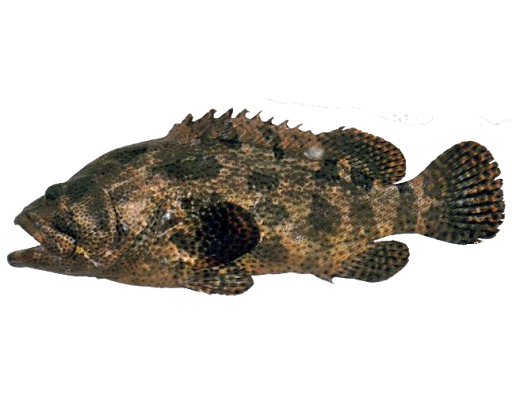The Brown-Marbled Grouper (scientific name: Epinephelinae), also known as the Tiger Grouper, is a species of fish renowned for its distinct appearance, aggressive hunting techniques, and culinary importance. However, many people are uncertain about whether this fish is a freshwater or saltwater species. In this article, we will delve into the classification, habitat, and environmental preferences of the Brown-Marbled Grouper to clarify whether it thrives in freshwater or saltwater environments.

The Brown-Marbled Grouper belongs to the family Epinephelinae, which includes numerous species of groupers. Groupers are generally known for their stout bodies, large mouths, and carnivorous feeding habits. The Brown-Marbled Grouper is a member of the Epinephelinae subfamily and is easily identifiable by its brown body adorned with marbled, or mottled, patterns. These fish are predators, using their powerful jaws and sharp teeth to catch smaller fish and invertebrates.
The Brown-Marbled Grouper is primarily a saltwater fish, inhabiting coral reefs and rocky coastal regions in tropical and subtropical areas. It is found in various parts of the world, including the Indo-Pacific region, South East Asia, and parts of the Indian Ocean. This fish thrives in the salty, mineral-rich waters of the ocean, and it prefers habitats such as:
Reef slopes
Coral reefs
Seagrass beds
The Brown-Marbled Grouper is well-adapted to life in saltwater, with specialized gills and osmotic processes that help it regulate the balance of salt and water in its body. Saltwater fish, including groupers like the Brown-Marbled Grouper, have evolved to cope with the high salinity of seawater and the pressures of deep-water habitats.
While the Brown-Marbled Grouper is a saltwater fish, it does have some flexibility when it comes to the environments it occupies. In its natural habitat, this grouper is most commonly found in shallow coastal waters, although it can occasionally be spotted at greater depths. These fish are territorial and typically reside in:
Coral reefs: These provide shelter, abundant food, and the right water conditions for the Brown-Marbled Grouper to thrive.
Rocky outcroppings: They prefer rocky, reef-like structures where they can hide and ambush their prey.
Mangrove swamps and seagrass beds: Some juvenile Brown-Marbled Groupers may inhabit these areas for protection during their early life stages before moving to more open reefs as they mature.
The Brown-Marbled Grouper has a wide distribution, predominantly in saltwater ecosystems around the Indo-Pacific region. This includes:
Philippines
Indonesia
Northern Australia
Vietnam
Thailand
The species is found at depths ranging from 10 meters to over 100 meters, depending on the region and availability of suitable habitats.
Unlike some species of fish that are capable of surviving in both freshwater and saltwater environments (known as euryhaline species), the Brown-Marbled Grouper is not one of them. This species is considered stenohaline, meaning it can only tolerate a narrow range of salinity levels. The saltwater environment provides the ideal conditions for the grouper to regulate its internal processes, such as maintaining proper hydration levels and feeding on the marine life it depends on.
| Aspect | Details |
|---|---|
| Scientific Name | Epinephelinae (Brown-Marbled Grouper) |
| Habitat | Saltwater (coral reefs, rocky outcroppings, seagrass beds) |
| Water Type | Saltwater (Cannot live in freshwater) |
| Geographical Range | Indo-Pacific region, Southeast Asia, Northern Australia, Vietnam |
| Preferred Depth | 10 to 100 meters below the surface |
| Diet | Carnivorous (smaller fish, crustaceans, and invertebrates) |
| Adaptations | Adapted to high salinity environments, powerful predatory capabilities |
In conclusion, the Brown-Marbled Grouper is a true saltwater fish that requires the saline conditions of the ocean to thrive. Its specialized adaptations to saltwater environments make it an important species in marine ecosystems, and it plays a critical role in the food web. If you're planning to observe or learn more about this fish, it's essential to recognize the key aspects of its saltwater habitat for proper care and conservation.
To summarize, the Brown-Marbled Grouper is undoubtedly a saltwater fish and cannot survive in freshwater environments. These fish are adapted to the specific conditions of the ocean, where they play a key role in the ecosystem as predators and bottom-dwellers. Found predominantly in tropical and subtropical coastal waters, the Brown-Marbled Grouper prefers habitats such as coral reefs and rocky outcrops, where it can find shelter and an abundant food source.
Understanding the natural habitat and environmental requirements of this species is crucial for conservation efforts and the sustainable management of marine ecosystems. If you're interested in keeping a Brown-Marbled Grouper in an aquarium, it's important to replicate the saltwater conditions of its native environment to ensure its health and well-being.
animal tags: Serranidae
We created this article in conjunction with AI technology, then made sure it was fact-checked and edited by a Animals Top editor.